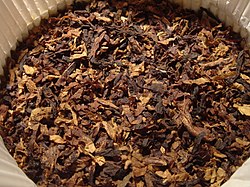Look up tobacco in Wiktionary, the free dictionary.
| Part of a series on |
| Tobacco |
|---|
 |
Nicotiana is the genus of herbs and shrubs which is cultivated to produce tobacco products.
Contents
- Actions
- Tobacco
- Types
- Products
- Pathogens
- Legal
- Legislation
- Court cases
- Agreements
- Movements
- Culture
- Campaigns
- Education
- Names
- Brands
- Businesses
- Persons
- Locations
- Organizations
- Other
- See also
Tobacco is an agricultural product processed from the fresh leaves of plants in the genus Nicotiana.
Tobacco may also refer to: